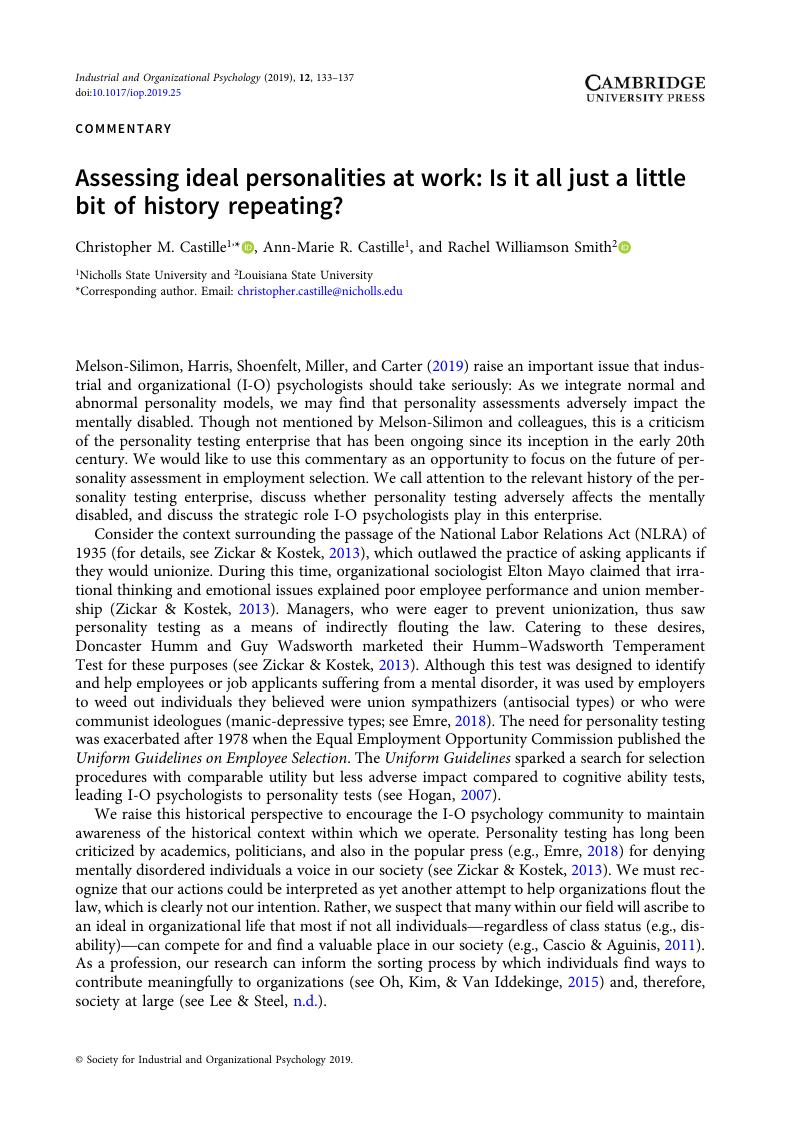No CrossRef data available.
Article contents
Assessing ideal personalities at work: Is it all just a little bit of history repeating?
Published online by Cambridge University Press: 01 August 2019
Abstract
An abstract is not available for this content so a preview has been provided. Please use the Get access link above for information on how to access this content.

- Type
- Commentaries
- Information
- Copyright
- © Society for Industrial and Organizational Psychology 2019
References
Aguinis, H., Mazurkiewicz, M. D., & Heggestad, E. D. (2009). Using web-based frame-of-reference training to decrease biases in personality-based job analysis: An experimental field study. Personnel Psychology, 62(2), 405–438. doi: 10.1111/j.1744-6570.2009.01144.x
CrossRefGoogle Scholar
Carter, N. T., Dalal, D. K., Boyce, A. S., O’Connell, M. S., Kung, M.-C., & Delgado, K. M. (2014). Uncovering curvilinear relationships between conscientiousness and job performance: How theoretically appropriate measurement makes an empirical difference. Journal of Applied Psychology, 99(4), 564–586. doi: 10.1037/a0034688
CrossRefGoogle ScholarPubMed
Carter, N. T., Dalal, D., Guan, L., Lopilato, A. C., & Withrow, S. A. (2017). Item response theory scoring and the detection of curvilinear relationships. Psychological Methods, 22(1), 191–203.Google ScholarPubMed
Cascio, W. F., & Aguinis, H. (2011). Applied psychology in human resource management (7th ed.). Upper Saddle River, NJ: Prentice Hall.Google Scholar
Chernyshenko, O. S., Stark, S., Drasgow, F., & Roberts, B. W. (2007). Constructing personality scales under the assumptions of an ideal point response process: Toward increasing the flexibility of personality measures. Psychological Assessment, 19(1), 88–106. doi: 10.1037/1040-3590.19.1.88
CrossRefGoogle ScholarPubMed
Dilchert, S., Ones, D. S., & Krueger, R. F. (2014). Maladaptive personality constructs, measures, and work behaviors. Industrial and Organizational Psychology, 7(1), 98–110. doi: 10.1111/iops.12115
Google Scholar
Emre, M. (2018). The personality brokers: The strong history of Myers-Briggs and the birth of personality testing. New York, NY: Doubleday.Google Scholar
Grant, A. M. (2013). Rethinking the extraverted sales ideal: The ambivert advantage. Psychological Science, 24(6), 1024–1030. doi: 10.1177/0956797612463706
CrossRefGoogle ScholarPubMed
Hogan, R. (2007). Personality and the fate of organizations. Mahwah, NJ: Lawrence Erlbaum Associates, Inc.Google Scholar
Huffcutt, A. I., Conway, J. M., Roth, P. L., & Stone, N. J. (2001). Identification and meta-analytic assessment of psychological constructs measured in employment interviews. Journal of Applied Psychology, 86(5), 897–913.CrossRefGoogle ScholarPubMed
Le, H., Oh, I.-S., Robbins, S. B., Ilies, R., Holland, E., & Westrick, P. (2011). Too much of a good thing: Curvilinear relationships between personality traits and job performance. Journal of Applied Psychology, 96(1), 113–133. doi: 10.1037/a0021016
CrossRefGoogle ScholarPubMed
Lee, C. I. S. G., & Steel, P. (n.d.). The potential of good selection: Simulating the impact of improved applicant matching on GDP. Currently under review.Google Scholar
Melson-Silimon, A., Harris, A. M., Shoenfelt, E. L., Miller, J. D., & Carter, N. (2019). Personality testing and the Americans with Disabilities Act: Cause for concern as normal and abnormal personality models are integrated. Industrial and Organizational Psychology: Perspectives on Science and Practice, 12(2), 119–132.CrossRefGoogle Scholar
Nickel, L. B., Roberts, B. W., & Chernyshenko, O. S. (2019). No evidence of a curvilinear relation between conscientiousness and relationship, work, and health outcomes. Journal of Personality and Social Psychology, 116(2), 296–312. doi: 10.1037/pspp0000176
CrossRefGoogle ScholarPubMed
Oh, I.-S., Kim, S., & Van Iddekinge, C. H. (2015). Taking it to another level: Do personality-based human capital resources matter to firm performance? Journal of Applied Psychology, 100(3), 935–947. doi: 10.1037/a0039052
CrossRefGoogle ScholarPubMed
O’Neill, T. A., Goffin, R. D., & Rothstein, M. (2013). Personality and the need for personality-oriented work analysis. In Christiansen, N. D. & Tett, R. T. (Eds.), Handbook of personality at work (pp. 226–252). New York, NY: Taylor & Francis.Google Scholar
Paulhus, D. L., Westlake, B. G., Calvez, S. S., & Harms, P. D. (2013). Self-presentation style in job interviews: The role of personality and culture. Journal of Applied Social Psychology, 43(10), 2042–2059. doi: 10.1111/jasp.12157
CrossRefGoogle Scholar
Peck, J. A., & Levashina, J. (2017). Impression management and interview and job performance ratings: A meta-analysis of research design with tactics in mind. Frontiers in Psychology, 8, 201. doi: 10.3389/fpsyg.2017.00201
Google ScholarPubMed
Raymark, P. H., Schmit, M. J., & Guion, R. M. (1997). Identifying potentially useful personality constructs for employee selection. Personnel Psychology, 50(3), 723–736. doi: 10.1111/j.1744-6570.1997.tb00712.x
CrossRefGoogle Scholar
Suzuki, T., Samuel, D. B., Pahlen, S., & Krueger, R. F. (2015). DSM-5 alternative personality disorder model traits as maladaptive extreme variants of the five-factor model: An item-response theory analysis. Journal of Abnormal Psychology, 124, 343–354. doi: 10.1037/abn0000035
CrossRefGoogle ScholarPubMed
Wu, J., & Lebreton, J. M. (2011). Reconsidering the dispositional basis of counterproductive work behavior: The role of aberrant personality. Personnel Psychology, 64(3), 593–626.CrossRefGoogle Scholar
Zickar, M. J., & Kostek, J. A. (2013). History of personality testing within organizations. In Christiansen, N. D. & Tett, R. P. (Eds.), Handbook of personality at work (pp. 165–182). New York, NY: Routledge.Google Scholar




